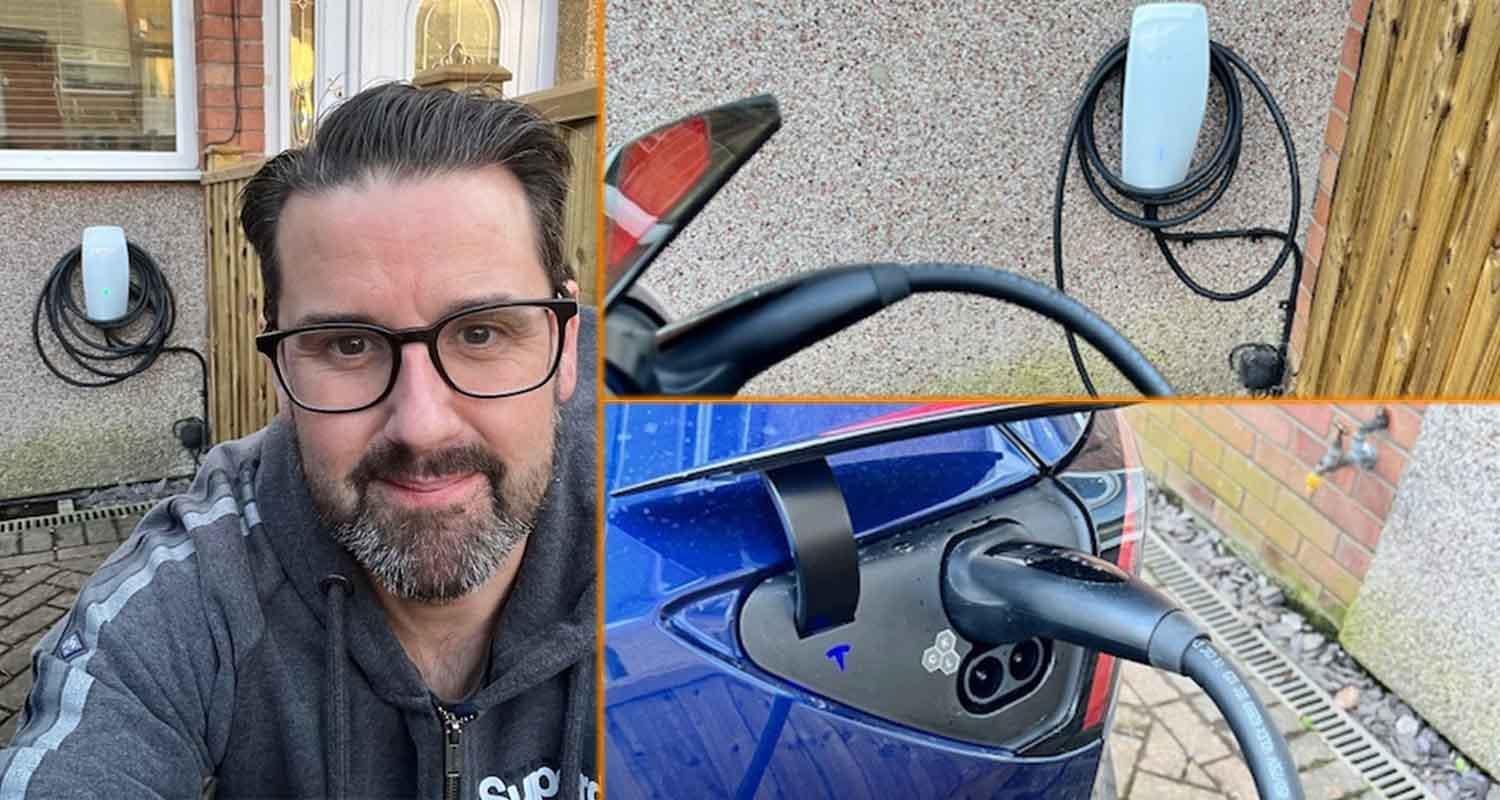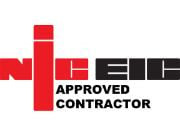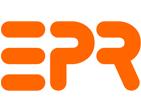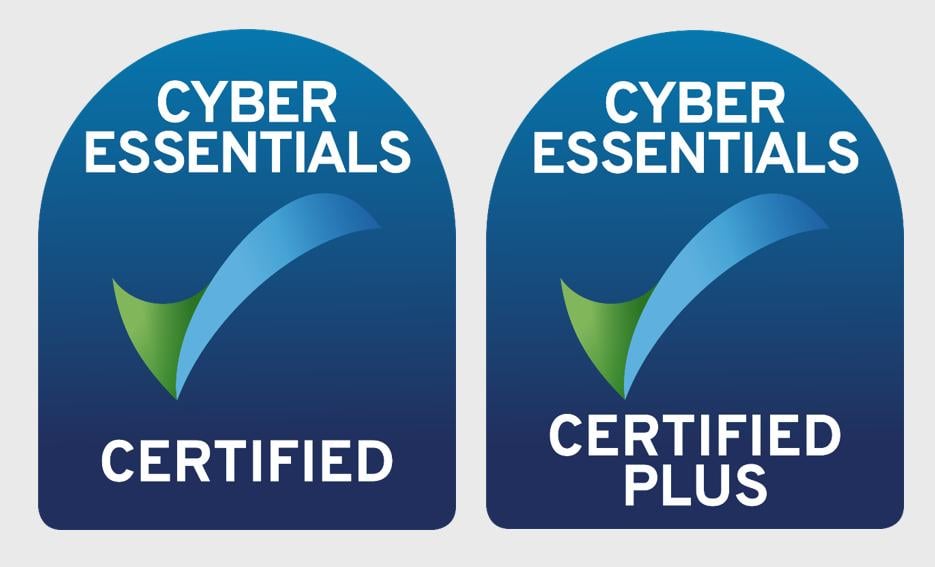How to use the Osprey Charging network - a complete guide
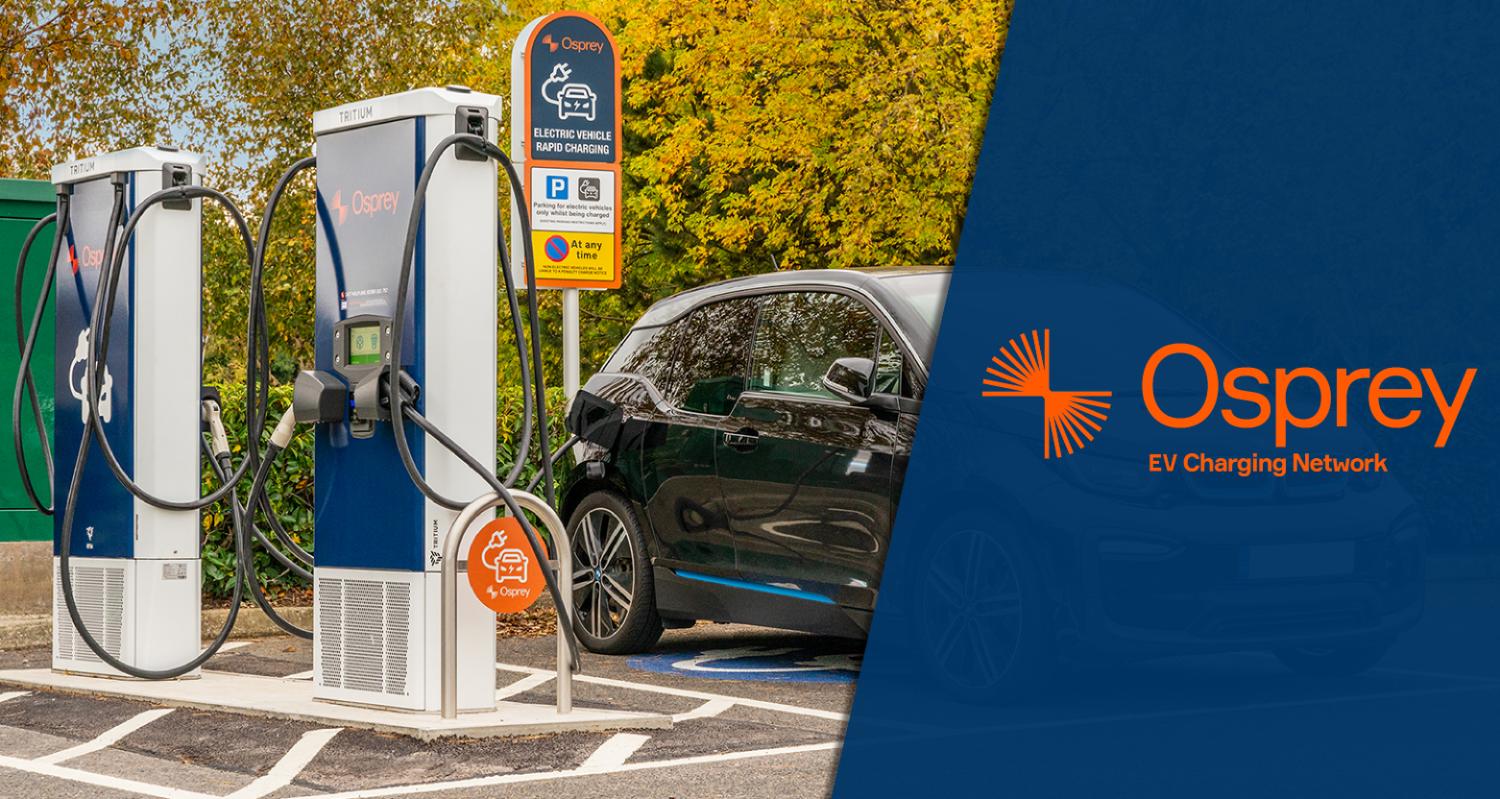
Osprey Charging is one of the fastest growing public EV charging networks in the UK and is also consistently ranked as one of the best. Here's our Complete Guide to Using the Osprey Charging Network.
Charge Card Compatibility | |||||
Fleet Charge card Compatibility (including but not limited to) | AllStar One Electric Card | Mina Chargepass | |||
Charging Speed | Up to 175kW | ||||
Price per kWh | £79 per kWh | ||||
Other Charges | N/A | ||||
Availability | |||||
Osprey Charging, is a rapid charging network that specialises in placing easy-to-use charge points in convenient locations throughout the UK (currently excluding Northern Ireland).
For now, the majority of Osprey charging stations charge at a rate of up to 50kW. This is, however, changing with the introduction of 75kW, 150kW and 175kW charge points in locations around the UK as well as at Osprey Charging hubs.
Osprey Charging prides itself on being an open-access network stating it “believes mass-market electric vehicle uptake will only happen if EV charging is totally accessible to the driver, on-demand at the moment that they need it and without any delays to getting connected”.
As a result, Osprey Charging prioritises compatibility on its charge points with all of them accepting charge cards including Electric Juice, Bonnet, Shell Recharge, Zap-Pay and manufacturer branded cards, as well as major fleet cards and more direct payment options including all contactless bank cards (except AMEX) and charging apps of which they also have their own.
And to drive the compatibility message even further, Osprey Charging continues to install charge points with a CHAdeMO connector, which is becoming an increasingly rare sight as more car manufacturers opt for CCS when designing their vehicles. Some of their charge points even have a type 2 connector for drivers with a plug-in hybrid or an EV that doesn't support rapid charging. Over time, Osprey anticipates phasing out the CHAdeMO cables and replacing them with CCS.
Get £5 free charging
Get £5 worth of free charging at Electric Universe supported charging networks when you sign-up using our link.
Where are Osprey Charging chargers located?
When it comes to charge point placement, Osprey Charging targets locations where EV drivers might typically park as they go about their day. These include coffee shops, council-owned car parks, supermarkets and selected Marston’s pubs, which is also one of Osprey's biggest partners.
Osprey Charging also operates multiple dedicated charging hubs for en-route charging. These charging hubs normally have around 6-8 150kW-175kW rapid charging points which can add 100 miles of range in around 10 minutes (depending on your vehicle). Osprey currently has charging hubs in Wolverhampton, Croydon, Banbury and Stratford with further new hubs in development in Suffolk, Essex, Glasgow, East Lothian, Birmingham, Crewe and Brackley for the near future.
How to spot an Osprey charge point
Osprey Charging typically uses a distinctive navy blue and orange colour scheme for its charge points, although this can change depending on where the charge point is situated - charge points located in Cardiff City Council's car parks are coloured blue and white for example. There are also many 50kW chargers with distinctive “blue sky” imagery, especially in Marston’s carparks.
Like a lot of charging network operators, Osprey Charging doesn’t make its own charge points. Instead, it purchases units from charge point manufacturers - Osprey currently uses four models of rapid charge points which will be pictured and listed below:
Tritium RTM 75
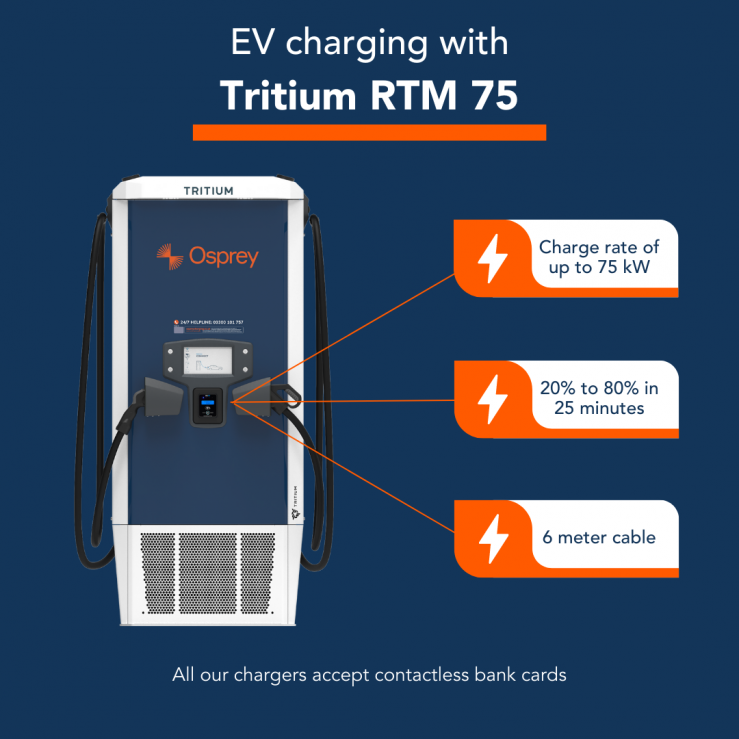
Capable of charging at a rate of up to 75kW, the Tritium RTM 75 is a slim rapid charge point that stands at just under two metres tall. On the front of the charge point under the Osprey logo, you will see a screen for displaying the charging status with a contactless card reader underneath. On either side of the card reader, you will see two charging connector holsters which house two six-metre CCS and CHAdeMO cables.
Tritium PK-175
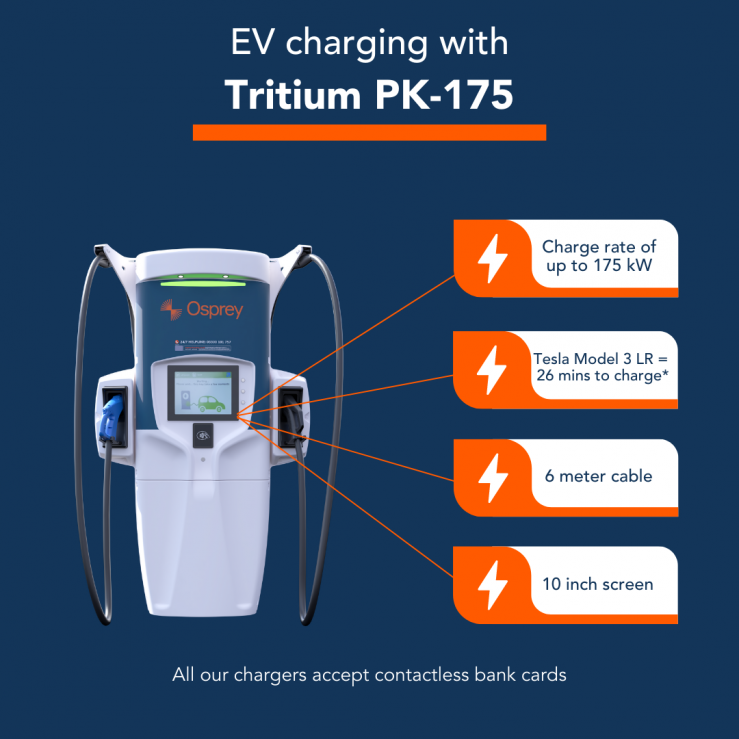
These charge points are the most powerful charge points in Osprey Charging’s portfolio, typically being able to charge a vehicle at a rate of up to 175kW. Looks-wise, the Tritium PK-175 charge points stand two metres tall and have two six-metre cables which protrude out on both sides of the top of the charge point and loop into holsters.
On the front of the unit under the Osprey Charging logo, you will see an LCD screen for displaying charging status with a contactless card reader just underneath it. On the sides of the charge point sits the holsters for the chargers' CHAdeMO and CCS connectors.
Raption 50
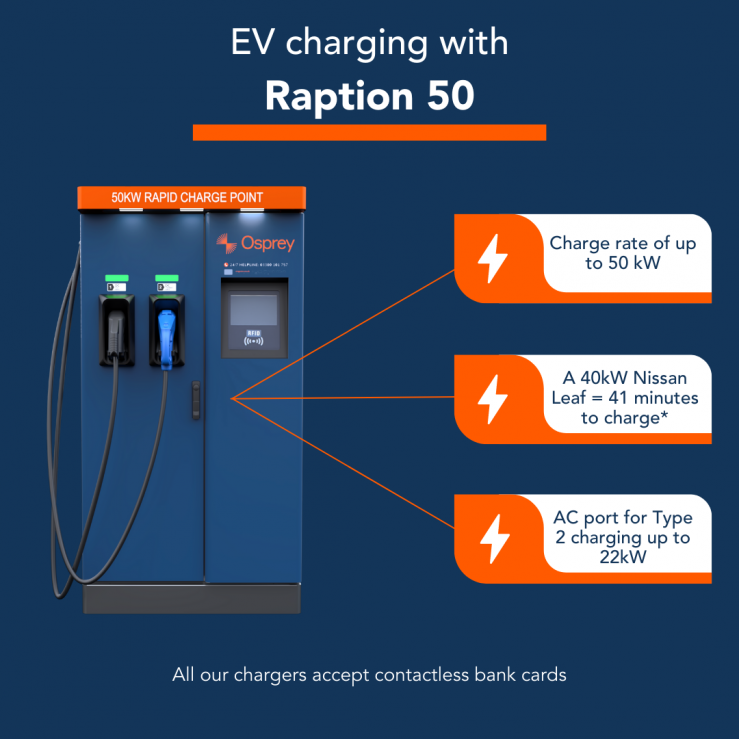
The Raption 50 is the first model Osprey installed in the UK. It is also probably the most common Osprey Charging charge point you will encounter on your travels. Standing at 1.8 metres tall, the Raption 50 has a bright orange top with the wording “50KW RAPID CHARGE POINT” in white lettering on the front.
The front of the charge point is divided into two halves, on the right half you will see a screen with an RFID card reader underneath and on the left half sits two charging holsters for a CCS and CHAdeMO connector. Unlike other charge points that Osprey Charging uses, the Raption 50 also has a 22kW AC Type 2 connector located on the right side of the charge point making it the only Osprey Charging charge point that can charge vehicles lacking a rapid charging connector.
Kempower S-Series

The newest charge point in Osprey's portfolio, and the one with the smallest footprint, is the Kempower S-Series. It stands at 2.3 metres tall and has a CCS and a CHAdeMO cable both of which protrude from the back of the charge point, loops up over the top of the charge point and into two connector cradles located under a display screen on the front.
These charge points are most commonly found at Osprey Charging’s dedicated hubs.
How do you pay for and access an Osprey charger?
There are three ways to use the Osprey charging network. You can pay via contactless payment, third-party charge cards such as Electric Juice or by using the Osprey charging’s dedicated app.
Contactless payment

Contactless payment such as a bank card or Apple/Google Pay is supported throughout the Osprey Charging network and is the most convenient method of paying due to there being no sign-up process to go through. To pay via contactless payment, first:
- Plug the appropriate connector into your vehicle. If you are charging via type 2 connector at a Raption 50 charge point, you will need to connect a charging cable to the port on the left side of the charge point and the opposite end of the cable into your vehicle.
- Tap “start charging” on the charge point’s screen.
- Select the connector type you have plugged into your vehicle.
- Present your contactless payment method to the card reader when prompted to do so. Upon approval of payment, the EV charge point will begin charging your vehicle.
To stop a charge session, simply tap “stop” on the charge point’s screen and present your contactless payment again. You will now be able to unplug your vehicle. In some vehicles, you will need to press the normal "unlock" on your car's key fob to release the cable.
Osprey App

If you would like to see your live charging status and charging history, download VAT reciepts from previous charge sessions and start and stop charge sessions remotely (obviously you will still need to plug and unplug the charging cable from your vehicle, that’s not automated… yet), then look no further than the Osprey Charging app.
To get started with the Osprey Charging app, first, you will need to:
- Download the Osprey Charging app, create an Osprey account and add a payment method
- Tap the charge points tab and search for the charge point you want to start a charge with by finding it on the map or searching for it using the search bar
- Once you have found the charge point that you want to charge at on the map
- Tap on the charge point’s icon, then tap on the connector type you want to use.
- Tap the appropriate ID number of the charge point you want to use (this can be found on a white sticker stuck to the front of the charge point).
- Remove the charging cable from the charge point and insert it into your vehicle's charging port.
- Finally, tap "start charging" on the app to begin your charge session.
A "session active" notification will appear on the Osprey Charging app. This will also provide live status updates of your current charge session.
To stop a charge session, tap "stop charging" from the session active screen, unplug the charging cable from your vehicle and place it back into its cable holster on the charge point unit.
Third-party service

Using a third-party service such as Octopus' Electric Juice to charge at an Osprey Charging charge point varies depending on the service you use. Because of this, we recommend viewing the instructions within the app of the third-party service if you are unsure. For our example, we are going to be using Octopus' Electric Juice.
- Plug the appropriate connector into your vehicle. If you are charging via Type 2 connector at a Raption 50 charge point, you will need to connect a charging cable to the port on the left side of the charge point and the opposite end of the cable into your vehicle.
- Tap “start charging” on the charge point’s screen.
- Select the connector type you have plugged into your vehicle.
- Present the included card/keyfob to the RFID card reader when prompted to do so. Upon approval of acceptance, the EV charge point will begin charging your vehicle.
To stop a charge session, simply tap “stop” on the ChargePoint’s screen and present your card/keyfob again. You will now be able to unplug your vehicle.
And speaking of Electric Juice... Get £5 free charging when you sign up to Electric Juice using our sign-up link.
How much does Osprey Charging Cost?
Osprey Charging keeps its rates simple. Whether you're using the 50kW Raption 50 or the high power 175kW Tritium PK-175, you'll only be charged £79 per kW. If you are a Bonnet customer using the Osprey Charging network, you will get a 50p discount due to Bonnet charging a flat rate of 50p (or less if you subscribe to Bonnet's refill packages) per kW.
How fast does Osprey Charging charge?
Charging speed at Osprey Charging depends on which type of charge point you are charging at and the charging speed of your vehicle. With the exception of the Kempower S-Series, Osprey Charging charge points have the charging speed in their model number. For example, the Raption 50 charge point, which is also Osprey Charging's slowest charge point, will charge your vehicle at a rate of up to 50kW.
Charging a little faster than the Raption 50 is the Tritium RTM 75 which can charge a vehicle at a rate of up to 75kW.
Next is the Kempower S-Series which charges a vehicle at a rate of up to 150kW.
Finally, there's Osprey Charging's fastest charge point, the Tritium PK-175 which charges a vehicle at a rate of up to 175kW.
It is important to bear in mind that your car will have its own “maximum charge rate” that it can draw from a charger, even if the charger itself can deliver a higher charge rate. The battery level (or “state of charge”), battery temperature and environment temperature can all affect the rate the car draws charge over time, and as the battery fills up the rate will drop off to protect the battery from overcharging – this is known as a “charging curve”.


